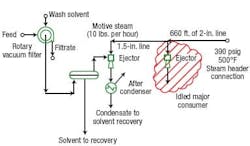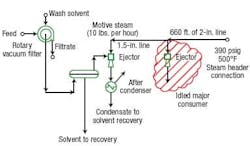Do some heavy thinking about light loads
Lowering the load on a plant can lead to unanticipated consequences. Consider what happened at a methyl ethyl ketone (MEK)/toluene dewaxing plant that used a rotary vacuum filter to remove wax crystals. The plant had run for decades without significant problems in the vacuum supply to the unit. Suddenly, in a space of a few months, getting sufficient vacuum became difficult.
Inspection revealed major erosion of the vacuum ejector. So, plant staff assumed they had found the cause of the problem old age had finally caught up with the plant.
Ejectors invariably suffer erosion. Theyre usually candidates for replacement whenever erosion opens up the throat cross-sectional area by more than 5%. This particular ejector was small and relatively inexpensive; so, the maintenance department quickly swapped it out. Unfortunately, the new ejector provided virtually no benefit.
Thats because the plant staff had identified the symptom not the root cause of the problem. This is always a danger in troubleshooting. Nearly everyone has a natural tendency to think theyve found the source of operating problems once they discover something not right. It takes experience and discipline to move toward more-thorough reviews that get to problem root causes.
Checklists can be a good start on making sure things arent missed. The first question on any troubleshooting checklist should be: What else has changed recently and how could it affect this problem?
Figure 1 shows a partial flow diagram of the plant and includes parts of the process as well as the ejector and steam systems. Superheated motive steam at 390 psig and 500°F came from the main steam header. The supply line was well insulated.
As already noted, this steam system had worked well for many years. However, just before the vacuum problem started, the site had shut down a different, much larger steam user downstream of the MEK steam connection. After the shutdown, the MEK vacuum ejector was the only load on the steam line. The main ejector for the MEK unit needed less than 10 lb/hr of steam. With only that steam rate, the existing line was too large. Even with insulation, the steam condensed in the 600 ft. of line from the header.
The ejector essentially was running as a liquid-driven unit. While its possible to get a liquid-driven ejector, its size and system design differ from that for steam. Its remarkable that the ejector did anything at all with condensate driving it. The liquid in the steam line caused the throat to erode. The throat erosion was another symptom, not the cause, of the problem. Failure to identify the root cause the first time forced the plant to shut down twice for repairs.
Installing a small electric heater to vaporize the condensate plus some auxiliary controls got the MEK ejector system working the way it was intended.
Load reductions can create as many problems as duty increases. So, always consider how plant systems will react to turndown conditions.

